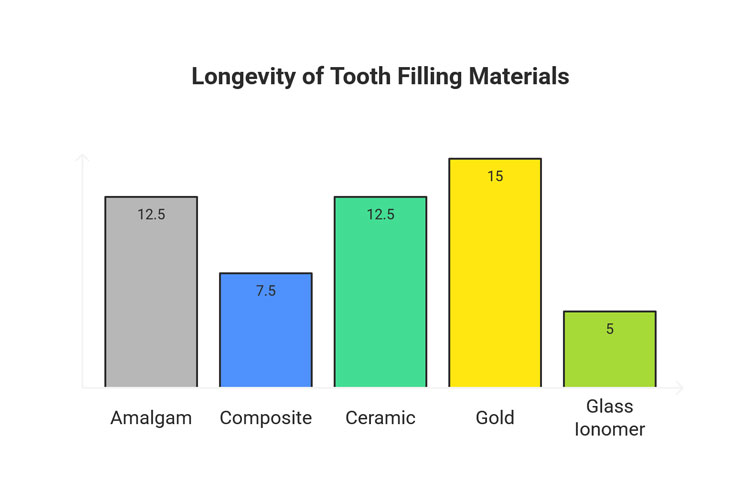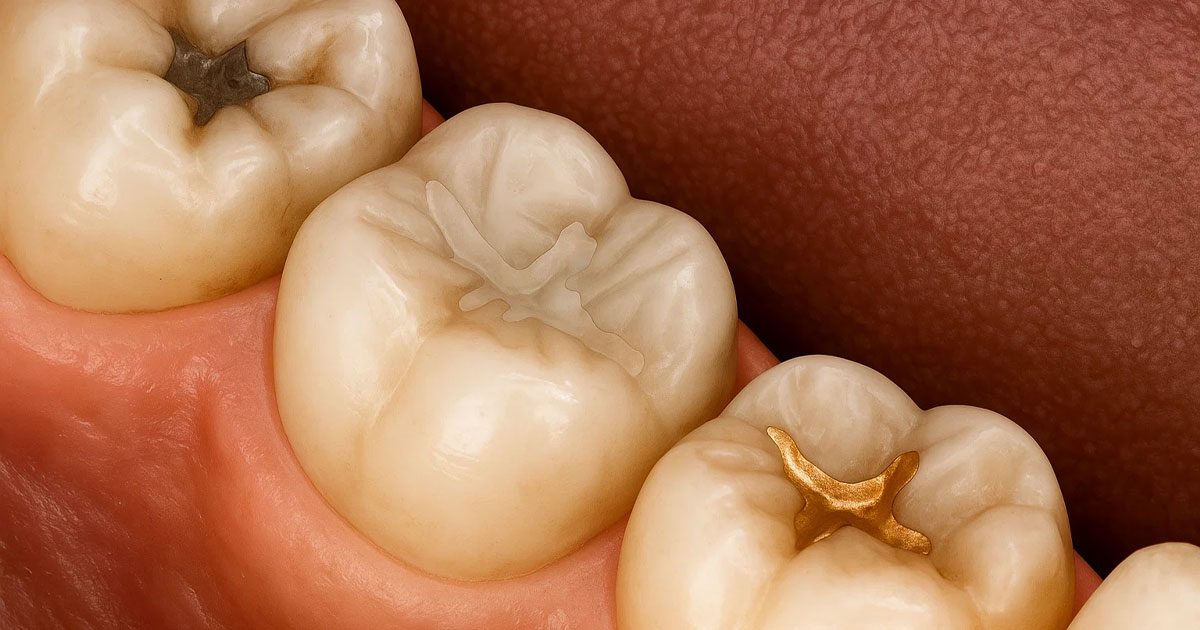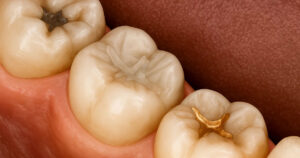When it comes to repairing cavities or restoring cracked teeth, choosing the right tooth filling types is key to long-lasting strength and protection. Today’s dentistry offers several options, each with unique benefits for durability, appearance, and cost. From traditional amalgam fillings to natural-looking composite fillings and versatile glass ionomer fillings, understanding the differences will help you make the best decision for your oral health. In this article, we’ll review the most common dental filling options so you can select the treatment that fits your needs with confidence.
Different Types of Dental Fillings
Dentists offer various options to fill teeth that have decay or damage. The most common types of dental fillings include amalgam, composite resin, ceramic, gold, and glass ionomer fillings. These fillings have varied features regarding strength, longevity, appearance, and affordability. For example, an amalgam is strong and long-lasting, while composite resin provides an appearance as good as natural teeth. Ceramic and gold fillings are more expensive but valued for their long life, while glass ionomer fillings provide fluoride to prevent cavities in teeth. Learning these options helps patients discover the best tooth filling types for their oral needs. Dentists may also recommend a dental crown when the decay is too extensive for a simple filling
| Filling Material | Appearance | Durability | Cost | Best For |
| Amalgam | Silver color | 10–15 years | Low | Back teeth, high chewing pressure |
| Composite | Tooth colored | 5–10 years | Moderate | Visible teeth, natural look |
| Ceramic | Tooth colored | 10–15 years | High | Aesthetic priority, stain resistance |
| Gold | Metallic gold | 15+ years | High | Strong chewing areas, longevity |
| Glass Ionomer | Tooth colored (opaque) | 3–7 years | Low to moderate | Children, fluoride release |
Related Article: Learn More About The CDCP Coverage in Canada

Amalgam Fillings Pros and Cons
Amalgam fillings have been in practice for decades and have been valued for their strength and affordability. They work best for molars under heavy chewing pressures. Patients appreciate their durability, as amalgam can last over ten years with proper care. Their silver appearance, however, makes it less ideal for front teeth, where aesthetics matter most. Other patients also fear mercury content, though mainstream health organizations consider them safe for use. Balancing these pros and cons helps determine when amalgam may be one of the best tooth filling types for back teeth needing extra durability.
Related Article: Check Your CDCP Status For Dental Coverage
Composite Fillings and Their Advantages
Composite fillings remain in favor due to their ability to match perfectly with normal tooth colour, and they’re best suited for visible areas of the mouth. Since they bond to the tooth directly, more of the original structure can be retained during insertion. Composite fillings have multi-functional properties as they can be used effectively for small to medium cavities, and they offer good resistance to fracture in areas of moderate stress. They are not as long-lasting as amalgam, but developments in dental technology have made composite fillers last much better than in the past. Composite is one of the most favourably perceived types of dental fillings due to both aesthetics and functional durability, says one patient.
Restore Your Smile with the Best Tooth Filling Types
At Danforth Dentistry in Toronto, we provide high quality dental filling treatments designed to protect and strengthen your teeth. Trust our team to recommend the best tooth filling types for your needs.

Direct vs Indirect Fillings
Fillings can also be categorized as direct or indirect depending on the placement technique. Direct fillings, consisting of composite or amalgam, are placed during a single visit to the mouth. Indirect fillings, including inlays and onlays, are custom-fabricated in a dental laboratory and, at a later visit, attached to the tooth through bonding. In some cases, dentists may also recommend a dental bridge if the tooth structure is not strong enough for a filling alone. Indirect fillings are usually more durable and stronger, and these can be utilized in larger cavities or in cavities under heavy chewing pressures. This allows patients to communicate better with their dentist and select which type provides the best fillings for long-term durability.
Related Article: CDCP Application Guide: Simple Steps to Apply for CDCP
Factors to Consider When Choosing Dental Filling Materials
Choosing an appropriate filling relies on various personal and clinical considerations. The position of the cavity, restoration size, and whether you can see the tooth while smiling dictate the choice. You also want to take into account cost, strength, aesthetics, and allergies. When it comes to children’s teeth, dentists often prefer glass ionomer due to its fluoride release, whereas adults often prefer composite or ceramic for aesthetic reasons. Patients who have grinding can often benefit from tougher fillings, including gold or amalgam. After considering these options, you can consult with your dentist and select appropriate types of tooth fillings based on an individual’s needs.
- Location of the cavity (front or back teeth)
- Size and depth of the filling required
- Appearance and color matching preferences
- Cost and budget considerations
- Longevity and strength needs
- Oral habits such as teeth grinding
- Age of the patient and fluoride benefits

How Long Do Different Tooth Fillings Last
Filling longevity relies significantly on material and maintenance. Amalgam fillings can last 10 to 15 years or more, whereas composite fillings last 5 to 10 years. Gold and ceramic fillings have been found to be long-lasting, at times over 15 years, if good oral hygiene practices are followed. Glass ionomer fillings typically last fewer years but provide protection in the form of fluoride release. Good dental checkup visits, proper brushing and flossing, and refraining from habits of biting hard materials will allow the best types of tooth fillings to be strong and functional long-term. Routine dental X-rays can also help identify early signs of filling failure.
- Amalgam fillings: 10–15 years or longer
- Composite fillings: 5–10 years
- Ceramic fillings: 10–15 years
- Gold fillings: 15 years or more
- Glass ionomer fillings: 3–7 years
Best Tooth Filling Types for Children and Adults
Children and adults may have different needs for dental fillings. Children might be recommended to have glass ionomer fillings due to their ability to release fluoride and being fast to load, which makes sense for younger patients. Adults prefer fillings to last and match their other teeth, and in this case, composite and ceramic fillings tend to be the option of choice, particularly for front visible teeth. Amalgam continues to be an option to consider for back teeth in both children and adults who require added strength to chew effectively. With considerations for age, oral health requirements, and lifestyle, dentists can help patients of all ages select the best tooth filling types for their individual situations.

Caring for Your Fillings After Treatment
Regular post-filling care ensures they last as long as possible. Patients must brush twice daily with fluoridated toothpaste, floss as often as necessary, and not chew very tough foods to prevent damaging the filling. Restricting sticky or sugary snacks decreases new decay forming around the restoration as well. Regular dental checkup appointments enable dentists to check fillings and detect initial indications of wear or cracks. Sensitivity or discomfort, if experienced, needs to be reported as soon as possible. Adhering to these easy steps helps patients receive optimal benefits and lifespan from the best tooth filling types available.
Trusted Care, Tailored for You
Protect Your Teeth With the Right Filling Choice
Choosing the best kind of tooth fillings depends on your personal dental needs, be it strength, original appearance, or economy, as different materials have different properties. From amalgam fillings to composite and glass ionomer fillings, understanding each material helps you to choose wisely.
At Danforth Dentistry, we offer skilled dental filling services to suit your oral requirements. Our experienced team also provides dental implants, veneers, teeth whitening, and orthodontics.
FAQ
-
What are the most common types of dental fillings?
The most common fillings are composite, glass ionomer, ceramic, gold, and amalgam, and these differ in strength, durability, and aesthetics.
-
How long do composite fillings last?
Composite fillings usually last between 5 and 10 years with proper care, although longevity also depends on the tooth’s location and oral hygiene habits.
-
Are amalgam fillings safe?
Amalgam fillings have been generally safe and effective, but there have been some patients who prefer composite or ceramic fillings because of aesthetic preferences.
-
When should a dental filling be replaced?
Fillings must be replaced if cracked, excessively worn down, or creating sensitivity. Regular checkup appointments at the dentist can identify early telltale signs of failed fillings.
Have you ever tried different dental fillings, or are you planning to get one soon? Share your experience or questions in the comments below. We would love to hear from you.





